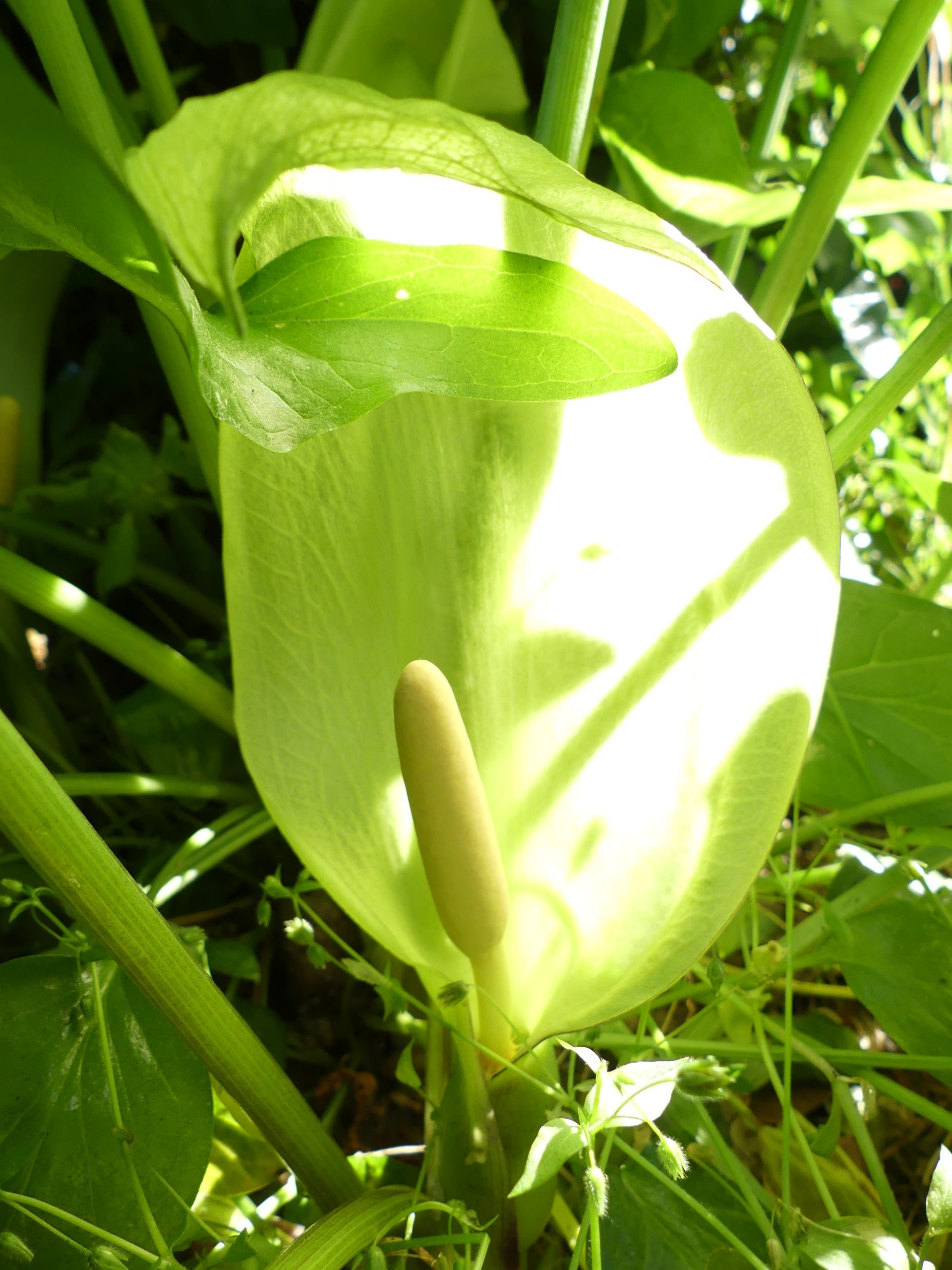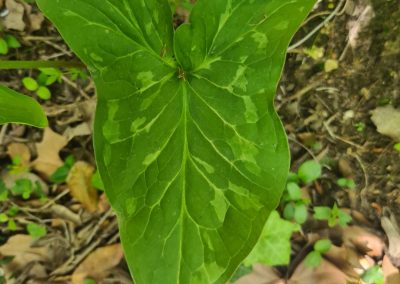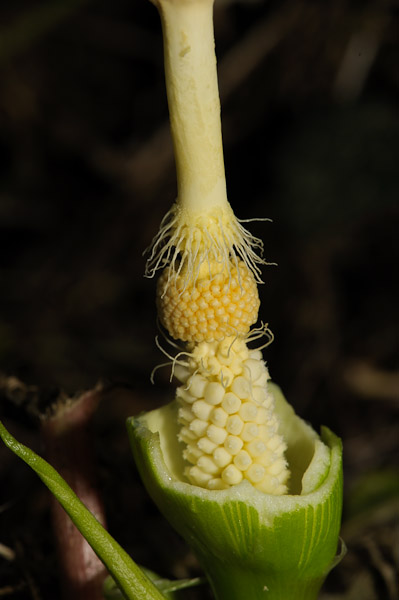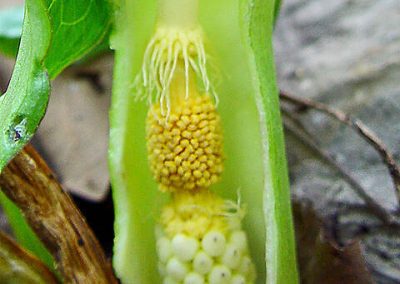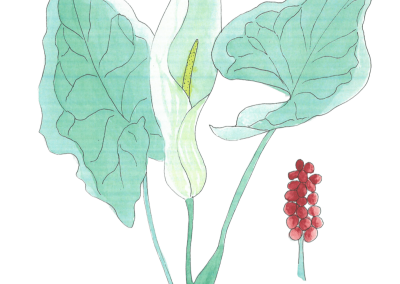Arum maculatum
Scientific description
Taxon: Arum italicum
Class: Magnoliopsida (Dicotyledons)
Subclass: Liliidae (sometimes classified as Monocotyledons depending on the system)
Order: Alismatales
Family: Araceae
Common name: Italian arum
Origin:
Southern and Western Europe, Mediterranean basin.
Description:
Arum italicum is a perennial tuberous plant growing between 20 and 80 cm tall. Its triangular, long-petioled, often wavy leaves appear before winter and have white or yellowish veins.
Flowering occurs in April and May, with an inflorescence surrounded by a white spathe. Male and female flowers are separated on the stem, with female flowers located at the bottom.
The inflorescence emits a smell resembling decaying matter. The plant is toxic and irritating to the skin.
Propagation:
Reproduces mainly by dividing tubers in spring or autumn. Seed propagation is possible but slower.
Ecology:
Grows in shaded or semi-shaded habitats, often in woodlands or forest edges, on rich, moist, well-drained soils. Adapted to temperate Mediterranean climates.
Use:
• Primarily ornamental
• Occasionally traditional medicine (with caution due to toxicity)
• Not edible
Taxon : Arum italicum
Classe : Magnoliopsidées (Dicotylédones)
Sous-classe : Liliidées (parfois classé parmi les Monocotylédones selon les systèmes)
Ordre : Alismatales
Famille : Aracées
Nom commun : Gouet d’Italie
Origine :
Europe méridionale et occidentale, bassin méditerranéen.
Description :
Arum italicum est une plante vivace tuberculeuse mesurant de 20 à 80 cm. Ses feuilles triangulaires, longues, pétiolées et souvent ondulées apparaissent avant l’hiver et présentent des veines blanches ou jaunâtres.
La floraison a lieu en avril–mai avec une inflorescence entourée d’une spathe blanche. Les fleurs mâles et femelles sont séparées sur la tige, les fleurs femelles étant à la base.
L’inflorescence dégage une odeur rappelant la matière en décomposition. La plante est toxique et irritante au contact.
Propagation :
Division des tubercules au printemps ou à l’automne. Multiplication par semis possible mais plus lente.
Écologie :
Pousse en milieux ombragés ou semi-ombragés, souvent en sous-bois ou lisières, sur sols riches, humides et bien drainés. Adaptée aux climats méditerranéens tempérés.
Utilisation :
• Principalement ornementale
• Parfois en médecine traditionnelle locale (avec précaution)
• Non comestible
Taxon: Arum italicum
Clasă: Magnoliopsida (Dikotiledonate)
Subclasă: Liliidae (uneori clasificată printre Monocotiledonate)
Ordin: Alismatales
Familie: Araceae
Denumire populară: Rodul pământului, Cucuruzul italian
Origine:
Europa de Sud și Vest, bazinul Mediteranean.
Descriere:
Arum italicum este o plantă perenă tuberculoasă, înaltă între 20 și 80 cm. Frunzele triunghiulare, cu pețiol lung și adesea ondulate, apar înainte de iarnă și prezintă vene albe sau galbene.
Înflorirea are loc în aprilie–mai, cu o inflorescență înconjurată de o spată albă. Florile masculine și feminine sunt separate pe tulpină, cele feminine fiind la bază.
Inflorescența emană un miros de descompunere. Planta este toxică și iritantă la contact.
Înmulțire:
Prin divizarea tuberculilor primăvara sau toamna. Semințele pot fi folosite, dar germinează lent.
Ecologie:
Preferă habitatele umbrite sau semiumbrite, deseori la marginea pădurilor, pe soluri bogate, umede și bine drenate. Adaptată la climatul mediteranean temperat.
Utilizare:
• Preponderent ornamentală
• Uneori în medicina tradițională (cu precauție)
• Nu este comestibilă
Ταξινόμηση: Arum italicum
Κλάση: Magnoliopsida (Δικοτυλήδονα)
Υποκλάση: Liliidae (μερικές φορές ταξινομείται στα Μονοκοτυλήδονα)
Τάξη: Alismatales
Οικογένεια: Αρακεία
Κοινό όνομα: Γκουέτ της Ιταλίας
Προέλευση:
Νότια και Δυτική Ευρώπη, μεσογειακή λεκάνη.
Περιγραφή:
Το Arum italicum είναι πολυετές φυτό με υπόγειους κονδυλώδεις βολβούς, ύψους 20–80 εκ. Τα τριγωνικά φύλλα, με μακρύ μίσχο και συχνά κυματιστά, εμφανίζονται πριν τον χειμώνα και έχουν λευκές ή κιτρινωπές νευρώσεις.
Ανθίζει τον Απρίλιο–Μάιο με ταξιανθία που περιβάλλεται από λευκή σπάθη. Τα αρσενικά και θηλυκά άνθη βρίσκονται ξεχωριστά στον βλαστό, με τα θηλυκά χαμηλότερα.
Η ταξιανθία μυρίζει σαν σάπια ύλη. Το φυτό είναι τοξικό και ερεθιστικό στην επαφή.
Πολλαπλασιασμός:
Αναπαράγεται κυρίως με διαίρεση κονδύλων την άνοιξη ή το φθινόπωρο. Η σπορά είναι δυνατή αλλά πιο αργή.
Οικολογία:
Αναπτύσσεται σε σκιερά ή ημισκιερά μέρη, συχνά σε δασικά όρια, σε πλούσια, υγρά και καλά στραγγιζόμενα εδάφη. Προσαρμοσμένο σε εύκρατα μεσογειακά κλίματα.
Χρήσεις:
• Κυρίως καλλωπιστικό
• Περιορισμένη χρήση στη λαϊκή ιατρική (με προσοχή)
• Μη βρώσιμο
Creative writing inspired by Arum maculatum
The story of Arum
In a deep valley, hidden in the heart of the forest, lived a mysterious plant called the arum. Its large, heart-shaped leaves seemed to protect an ancient secret, and its flower, a white spathe wrapped around a golden spadix, shone in the moonlight like a lighthouse. Those who knew the place said it held the key to an ancient power, hidden for centuries.
One day, a young botanist named Julien heard about this legendary flower. Curious and determined, he set out to find it. He had been told that the arum only revealed itself to those who deserved to understand its wisdom, and that its beauty hid a fragile and delicate power.
Crossing the forest, Julien observed the arum in its natural habitat, a mysterious shadow among the dense foliage. The plant, though beautiful, was also dangerous. Its roots could be poisonous if one was not careful.
He returned every day and came across a young botanist, Jeanne, who was also intrigued by this mysterious flower. Julien and Jeanne arranged to meet to talk about the arum and share their passion.
As the days passed, their bond grew stronger, and the two fell in love, deciding to visit the plant regularly, which had become the symbol of their love.


